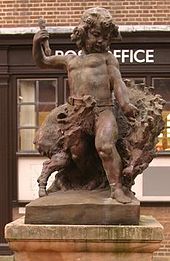Dryad 是希臘神話中的女神,守護森林和樹木的女神。
A dryad (/ˈdraɪ.æd/; Greek: Δρυάδες, sing.: Δρυάς) is a tree nymph, or tree spirit, in Greek mythology. In Greek drys signifies "oak". Thus, dryads are specifically the nymphs of oaktrees, though the term has come to be used for all tree nymphs in general.[1] "Such deities are very much overshadowed by the divine figures defined through poetry and cult," Walter Burkert remarked of Greek nature deities.[2] They were normally considered to be very shy creatures, except around the goddess Artemis, who was known to be a friend to most nymphs.
| Greek deities series |
|---|
| Nymphs |
Contents
[hide]Meliai[edit]
The dryads of ash trees were called the Meliai.[1] The ash-tree sisters tended the infant Zeus in Rhea's Cretan cave. Gaea gave birth to the Meliai after being made fertile by the blood of castrated Uranus. Nymphs associated with apple trees were the Epimeliad, and those associated with walnut-trees were the Caryatids.[1]
Hamadryad[edit]
Dryads, like all nymphs, were supernaturally long-lived and tied to their homes, but some were a step beyond most nymphs. These were the hamadryads who were an integral part of their trees, such that if the tree died, the hamadryad associated with it died as well. For these reasons, dryads and the Greek gods punished any mortals who harmed trees without first propitiating the tree-nymphs. (associated with Oak trees)
Names[edit]
Some of the individual dryads or hamadryads are:
- Atlanteia and Phoebe, two of the many wives or concubines of Danaus[3]
- Chrysopeleia[4]
- Dryope[5][6]
- Erato[7]
- Eurydice
- Phigalia[8]
- Pitys[9][10]
- Tithorea[11]
In the arts and culture[edit]
- Dryads are mentioned in Milton's Paradise Lost, in the works of Coleridge, and in Thackeray's novel The Virginians.[12] Keats addresses the nightingale as "light-winged Dryad of the trees", in his "Ode to a Nightingale". In the poetry of Donald Davidson they illustrate the themes of tradition and the importance of the past to the present.[13] The poet Sylvia Plath uses them to symbolize nature in her poetry in "On the Difficulty of Conjuring up a Dryad", and "On the Plethora of Dryads".[14]
- The story "Dear Dryad" (1924) by Oliver Onions features a dryad influencing several romantic couples through history.[15]
- In Act II of Marius Petipa's ballet "Don Quixote" the corps de ballet interpret dryads in the "Dream Scene" with a variation from the Queen of the Dryads.
資料來源
https://en.wikipedia.org/wiki/Dryad
https://zh.wikipedia.org/wiki/宁芙

沒有留言:
張貼留言